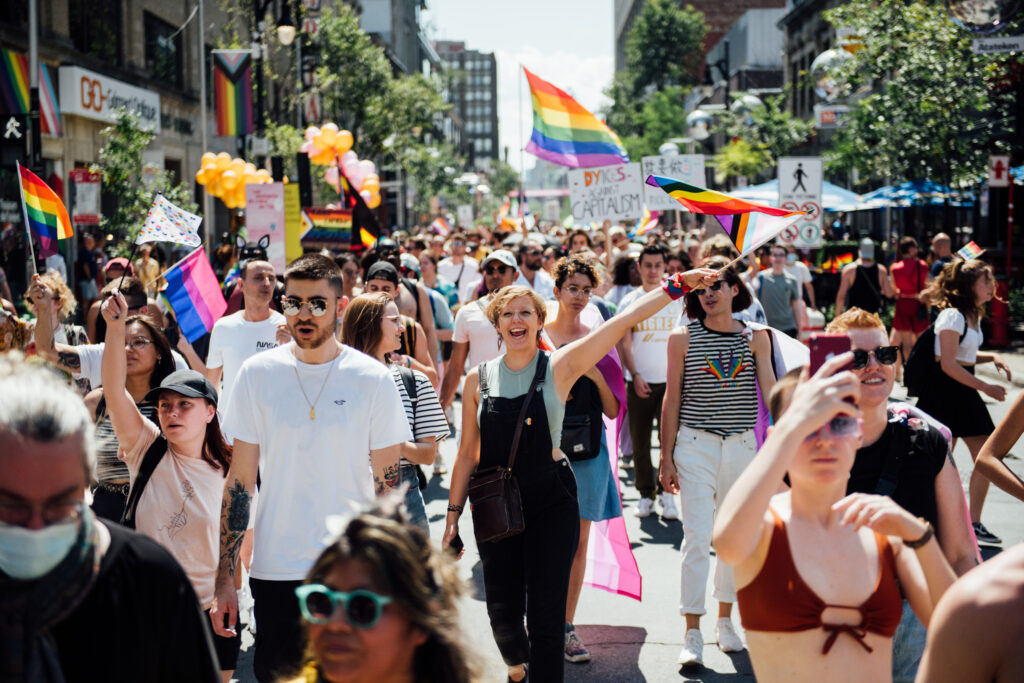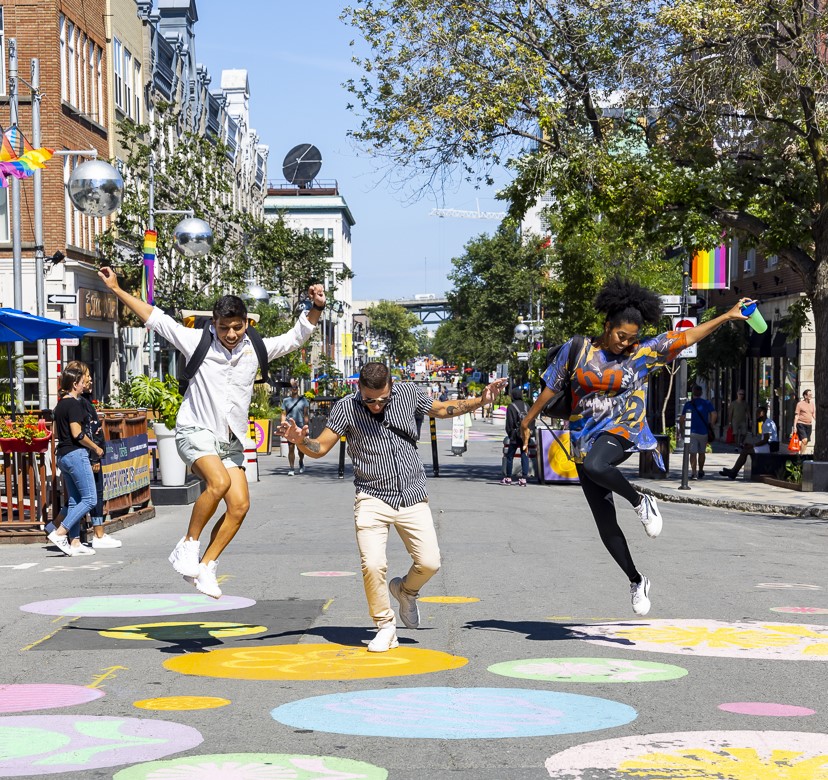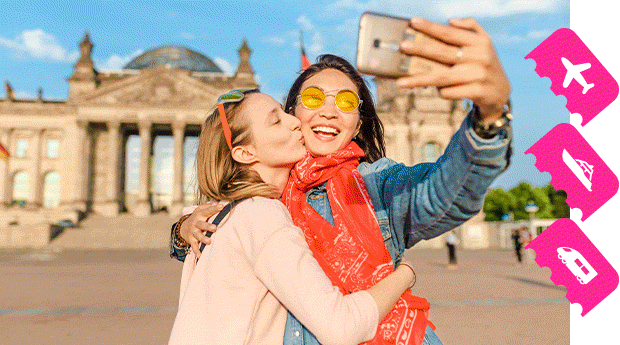Montreal has never been completely on the straight and narrow with its visitors—not in its famous nightlife and certainly not geographically.
Some of the city’s streets names end with nord, sud, est or ouest (French for north, south, east and west), but they don’t reflect the cardinal points of the compass. Instead, the city’s grid follows the path of the Saint Lawrence River in this area of the province of Quebec, which runs roughly at a 45-degree angle to the perpendicular. The result is that the sun appears to set more in the north, not the west.
This international city, beloved by its fans for its excellent food scene and sexy nightlife, has been charting its own path since the French arrived in the 1600s, and it has worked. Montreal, which has a metro area population of about 4.3 million, is a slice of Europe in North America—foreign but familiar, and less than a two-hour flight from major cities in Canada and the northeastern United States. Its citizens exude a joie de vivre, partying hard on a Saturday night, atoning for their sins Sunday morning and ramping up again Monday doing a cinq à sept (early-evening drinks) with their friends. Not what you would expect from a city where Catholic crosses and churches dot the landscape. Then again, west is north here.
For centuries, that forced perspective on the world extended to society, where members of the LGBTQ2S+ community were confined to the rigid rules and roles of French, British and later Canadian society. Unless, of course, just like when you realize where exactly the sun is setting, you begin taking a closer look and discover some of their sometimes sad and sometime inspirational stories of bucking social conventions.
That is the theme behind the Queerstory Tour (tour begins at Boulevard de Maisonneuve and Rue Saint-Mathieu, in front of the Guy-Concordia metro station), a guided walk in Canada’s second-largest city, that reveals some of the little-known stories of the community over the centuries, from the 1700s military drummer caught in the wood committing “the worst of crimes” with an Indigenous man, to the riots and demonstrations against police brutality in the 1990s.
“I am guiding you through their experiences,” says Thom Seivewright, founder of Tours Montreal. He started the Queerstory Tour during the pandemic, starting out researching documents and newspapers, but also conducting interviews with many of the people who were involved in the pivotal events that took place during the second half of the 20th century. “I got lucky ’cause a lot of them are still here and alive.”
The three-hour tour starts at a corner on the edge of Concordia University, recognizing the former site of the city’s original gay village, before winding its way for about three kilometres through the city.
During the tour, Seivewright—who carries his small dog, Jinx, in an open padded bag slung over his shoulder—recounts the stories associated with all the letters in the LGBTQ2S+ acronym. He explains the special reverence Two-Spirit peoples had in the Indigenous community that made its home at the base of what is now known as Mount Royal, the central mountain the city is built around, to the story a former female wrestler who opened a lesbian-only bar, Baby Face, in the 1970s and then, one day, simply disappeared.
His tour also chronicles the final days of the city’s old gay village, which went into decline after attempts by the city’s then mayor, Jean Drapeau, to clean the neighbourhood of “undesirables” in time for the 1967 World’s Fair (called Expo 67) and then again leading up to the 1976 Summer Olympics. Things get more upbeat when Seivewright talks about the rise of Montreal’s current Village—which is centred on Rue Sainte-Catherine and is roughly bordered by Rue Saint-Hubert to the west and Avenue de Lorimier to the east—and the equal rights that LGBTQ2S+ people have in Montreal.
“This is me paying tribute to the people who paved the way for me to be able to make my life as a queer person in this city,” said Seivewright.
What to see and do

Fierté Montréal, also called Montreal Pride, takes place in early August of each year and features 11 days of events and celebrations that culminate in the annual parade. The festival’s roots date back to 1979, when John Banks, a local activist who used to be the assistant to Marlene Dietrich and whom you learn about on the Queerstory Tour, led a 52-person rights march in the city.
Major mainstream festivals. Fierté is just one of the annual events that takes place in Montreal, which is known as a city of festivals, with one taking place most weeks of the year. Other big events include the popular Montréal en lumière, a February celebration that combines performing arts, gastronomy and outdoor events, the Festival International de Jazz de Montréal in June and the Just For Laughs comedy festival in July; over the years Just For Laughs has definitely increased the number of queer comedians it showcases. The city even has a downtown district called the Quartier des spectacles with eight public spaces that host around 40 festivals each year.
The Village (along and around Rue Sainte-Catherine between the Berri-UQAM and Papineau Metro stations). The largest LGBTQ2S+ neighbourhood in Canada, the pedestrian-only main zone is decorated with art installations through part of the year. The area features a mix of businesses, cafés, bars and restaurants, and is also home to the St. Peter the Apostle Catholic Church (1201 Rue de la Visitation), which contains the only chapel in the world dedicated to victims of HIV/AIDS.
Mount Royal Park (accessible from many streets including Chemin de la Côte-des-Neiges and Avenue des Pins Ouest). Montreal’s backyard is a 200-hectare, four-season playground designed by Frederick Law Olmsted, who was also responsible for Central Park in New York City. Explore the park’s extensive trail system by foot, bike or snowshoe (depending on the season) or taking in the panoramic city views from its various lookouts—known as a belvédère in French.
La Grande roue de Montréal (362 Rue de la Commune St. Est). This observation wheel has gondolas that seat up to eight people as it slowly rotates to a height of 60 metres next to the St. Lawrence River in the old port.
Port of Montreal Tower (200 Rue de la Commune St. Est). Want to go even higher? This glassed-in 65-metre-high tower, next to the cruise ship terminal, also offers stunning views.
Pointe-à-Callière (350 Place Royale). Also known as the Montreal Museum of Archaeology and History, this complex is built over the footprint of the original settlement of the city, Fort Ville-Marie, which dates back to 1642. You can walk on see-through floors above the architectural remains of those buildings—and maybe even in the footprints of that military drummer, who was able to have his death sentence for “the worst of crimes” commuted when he agreed to become Montreal’s first executioner.
Immersive light and sound shows are popular in the city, with various performances taking place regularly. Notre-Dame Basilica (110 Rue Notre-Dame Ouest) is home to The AURA Experience, a four-act display of lights and orchestral music against the architectural backdrop of the interior of the Gothic Revival-style church. OASIS Immersion (301 Rue Saint-Antoine Ouest) feels more like a club experience with its dynamic walk-through spaces; one of its 2023 shows, Sweet Folie, is like being inside a cute and offbeat game app. During certain times of the year, Montréal en Histoires’ Cité Mémoire sees stories from the city’s past video projected onto the sides of various buildings in the old city and port district.
Spade & Palacio Tours (3801 Rue Saint-Denis #B, Montreal). This LGBTQ2S+-inclusive small-group tour of the city’s murals takes you to several of the massive two- to nine-storey-high murals located around Boulevard Saint-Laurent in the Plateau area of the city. The murals were created by international artists as part of past festivals or by local artists. The side of a high-rise building downtown on Rue Crescent is home to a 926-square-metre mural of Leonard Cohen (straight, but pretty sexy), the singer of “Suzanne,” “Hallelujah” and “Everybody Knows,” who grew up in Montreal.
The McCord Stewart Museum (690 Rue Sherbrooke Ouest) is home to several exhibits chronicling life in the city, both past and present, along with the diverse communities that call Montreal home. On display through Feb. 4, 2024, is Mother Memory Cellophane by Séamus Gallagher, which uses elements of drag culture to explore the fact that mother, memory and cellophane were found to be the most beautiful words in the English language in a 1940 survey. (It was taken after the previous year’s New York World’s Fair, where cellophane debuted as a miracle product.)
Montreal Olympic Park (Metro stops Pie-IX or Viau, accessible from Avenue Pierre-de Coubertin and other streets). The spot where the 1976 Summer Olympics (and three decades later, the 2006 World Outgames, a now defunct LGBTQ2S+ multisports event) were held. Many of the original structures have now been reimagined for new uses, including the velodrome (cycling stadium) that now houses the Montreal Biôdome (4777 Avenue Pierre-de Coubertin), which features replicas of four different ecosystems found in North and South America. The Rio Tinto Alcan Planetarium is also located in the park.
Bota Bota (intersection of rues De la Commune and McGill). For a little pampering, jump aboard this historic river ferry on the Saint Lawrence river, now a floating spa offers a range of beauty treatments, yoga and a restaurant. There’s a water circuit (alternating between hot and cold), massages and other spa services.
Where to stay
Fairmont The Queen Elizabeth (900 Boulevard René-Lévesque Ouest). Opened in 1958, this grand railway-station hotel was where John Lennon and Yoko Ono held one of their Bed-ins for Peace in 1969 and where they recorded one of the versions of their iconic song “Give Peace a Chance.” The property was extensively renovated in 2017 and the bar, Nacarat, is worth a stop for a smart drink.
Montreal Marriott Chateau Champlain (1050 Rue De la Gauchetière Ouest). First opened as part of Expo 67, the property was recently renovated with a crisp, modern look. It is home to the retro theatre Le Caf ’Conc—think black marble, plush red-and-gold accents—which opened in the late 1960s; it will begin hosting cabaret performances in March 2024.
Hyatt Centric Montreal (621 Rue Notre-Dame Est). Located on the edge of the old port next to a historic train station, it is only a 10-minute walk to the Village. The hotel opened in December 2022 and features a rooftop pool on its 14th floor, offering spectacular vistas of the city, Mount Royal and the Saint Lawrence River.
Hôtel Alt Montréal (120 Rue Peel) is nestled at the base of Rue Peel in the vibrant Griffintown neighbourhood. They offer flexible departure times, a well-equipped gym and simple-yet-comfortable rooms. The property is pet-friendly if you want to bring along your four-legged friend.
W Montreal (901 Rue du Square-Victoria). Housed in the former Banque du Canada building, this upscale spot has 124 rooms and 28 suites over 10 floors. Rent its private karaoke space, inspired by Japan’s iconic Shinkansen train, where you can sip on sake-based cocktails while belting out tunes.
Hotel Manoir Sherbrooke (157 Rue Sherbrooke Est). Close to the Village, this is a small LGBTQ2S+-friendly spot that makes it easy to walk home from the bars.
Where to eat
St-Viateur Bagel Shop (263 Rue Saint-Viateur Ouest). Operating since 1957, this celebrated stop is considered by many to have the best of the chewy Montreal-style bagel the city is known for. But they haven’t quite cornered the market. Fairmount Bagel (74 Avenue Fairmount Ouest), which traces its history back to 1919, is the oldest in the city. Bagel St-Lo (5411 Rue de Verdun, Verdun, a suburb of Montreal), MTL Bagel Shop (5452 Avenue Westminster, Côte Saint-Luc, a suburb of Montreal) and Real Bagel Décarie (4940 Chemin Queen-Mary) are all worth checking out.
Shop and eat lunch at one of Montreal’s markets, which are known for their farm-fresh produce, meat shops, florists, cheesemongers, artisanal products like local honey and maple syrup, and popular food trucks. Among the most popular are the Jean Talon Market (7070 Avenue Henri-Julien) and the Atwater Market (138 Avenue Atwater)
Crew Collective & Café (360 Rue Saint-Jacques). The coffee shop and coworking space is located in a former Royal Bank of Canada that was built in the old city in the 1920s. Many of the bank’s original details were kept, including its marble mosaic floor, opulent golden chandeliers and cathedral-like ceiling intricately designed with wood and gilding. A glam place for a made to-order latte, espresso or Americano.
Time Out Market Montréal (705 Rue Sainte-Catherine Ouest). Located in the Eaton Centre, this is a hip food hall featuring food from some of the city’s best-known chefs and restaurants, as well as three bars, a cooking school and performance area. Also popular is the more relaxed setting at Le Central (30 Rue Sainte-Catherine Ouest), which has stalls serving poke bowls, tapas, pizza and ramen in the Quartier des spectacles area of downtown.
Montreal is known for its vibrant Jewish community that emigrated from Eastern Europe and brought with it what has developed into a local culinary tradition: Montreal-style smoked meat. One of the most iconic spots to try it is Schwartz’s (3895 Boulevard Saint-Laurent), a Jewish delicatessen first opened in 1928 that is known for its smoked-meat sandwiches served with sides such as a half-sour pickles and fresh coleslaw.
Where to party
The Village is full of spots where you can spend a fun-filled night out, but there are many queer-friendly neighbourhoods.
Bar le Stud (1812 Rue Sainte-Catherine Est). A local LGBTQ2S+ institution since it first opened in 1995, Le Stud has grown to have three different bars and even a restaurant. A place for a casual drink, a bit of karaoke and even cruising.
Aigle Noir (1315 Rue Sainte-Catherine Est). Aka the Black Eagle, this two-storey venue is popular with the bear, jean and leather crowds. It’s more mature earlier in the evening, but attracts a more diverse crowd as the night goes on.
District Video Lounge (1365 Rue Sainte-Catherine Est). You and your friends can request music videos from a bank of more than 85,000 of them at this straight-friendly Village bar. Make some intriguing selections and you’ll make new friends with people who love (or are shocked by) your taste in music.
Club Unity (1171 Rue Sainte-Catherine Est). This long-standing DJ-focused hot spot might be the city’s biggest “inclusive” club—gay but straight-welcoming. It’s got two dance rooms, a VIP area and a rooftop terrace.
Complexe Sky (1478 Rue Sainte-Catherine Est). Also a great place for dancing, but this multilevel gay club has also got drag shows, an eatery, a pool and a spa.
Cabaret Mado (1115 Rue Sainte-Catherine Est). This 1920s-inspired nightclub, owned and operated by legendary local drag queen, author and singer Mado Lamotte, is the city’s drag HQ and an essential stop for those who love the art form.
Bar Le Cocktail (1669 Rue Sainte-Catherine Est) is a great place for drag and karaoke, with performances every Thursday through Sunday nights.
Stock Bar (1171 Rue Sainte-Catherine Est). Montreal is known for its strip bars. Though the number of them has gone down since their heyday in the 1970s and ’80s, there are still about 50, including several ones featuring male dancers and mostly male clientele. Stock has been one of the city’s most popular gay strip clubs since it first opened in 1996. Campus (1111 Rue Sainte-Catherine Est) is also popular. Café Cléopatre (1230 Boulevard Saint-Laurent) features female strippers on its first floor and vaudeville/cabaret-style performances on its second floor.
Beyond the Village, there are several queer-friendly bars and nightclubs throughout the city (some host weekly LGBTQ2S+-themed nights). Sports fans will want to visit the Bar Champs (3956 Boulevard Saint-Laurent) a three-storey, LGBTQ2S+ bar that shows games from around the world on its walls of TV sets, or the women-owned Bar Notre-Dame des Quilles (32 Rue Beaubien Est) a popular Little Italy spot known for its cocktails and its two old-school bowling lanes (you need to set the pins up yourself). The vibe is anime-meets-cabaret.
The Village is home to several long-standing gay bathhouses. It’s a competitive business and you’ll find the admission prices cheaper here than in many other cities, especially if you take note of time-of-day and time-of-week discounts. Two of the biggest and most popular are Sauna G.I. Joe (1166 Rue Sainte-Catherine Est, Montreal) and Sauna Oasis (1390 Rue Sainte-Catherine Est).
Where to gear up
Priape (1311 Rue Sainte-Catherine Est). Opened in 1974, this emporium of manliness sells leather, jockstraps, toys and other accoutrements to try out in the club or your hotel room.
Armada par The Men’s Room (1359 Rue Sainte-Catherine Est). Leather? Check. Lube? Check. More underwear than you can fit in your suitcase? Check. Service in English or French.
Simons (977 Rue Sainte-Catherine Ouest.). For some style-conscious gay travellers, the HQ of this Quebec-based fashion retailer is reason enough to visit Montreal. The mix of designer and house brands, at a wide range of price points, makes it very hard to leave the store without a purchase. Like so much Quebec style, it’s on trend—even ahead of the curve. Minimal chic? They’ve got it. Over-the-top flash? They’ve got that too.
L’Euguélionne (1426 Rue Beaudry). A feminist co-op in this day and age? Magnifique! Queer events and coffee. And their collection of LGBTQ2S+ titles is excellent.
Librairie Gallimard (3700 Boulevard Saint-Laurent). For those who read French and have sophisticated tastes, this is where you’ll find your Foucault and your Judith Butler (in translation, of course).
Editor’s note: Portions of the writer’s trip to Montreal was covered by Bonjour Québec and Tourisme Montréal. The sponsors of the trip did not direct or review coverage. The views expressed are the writer’s own.


